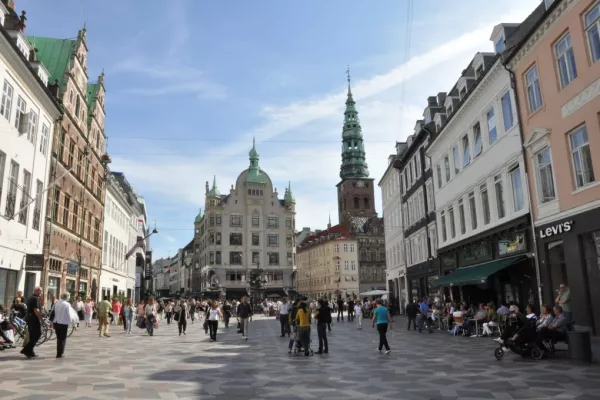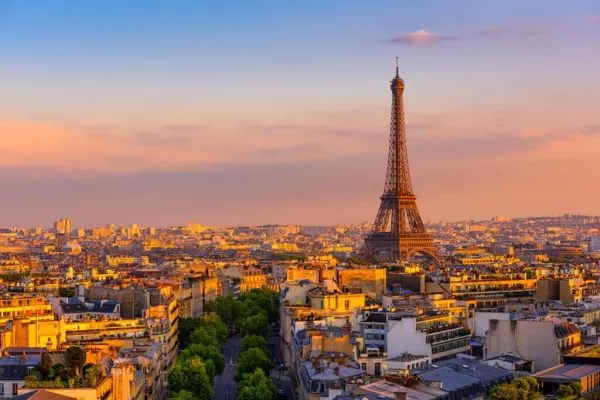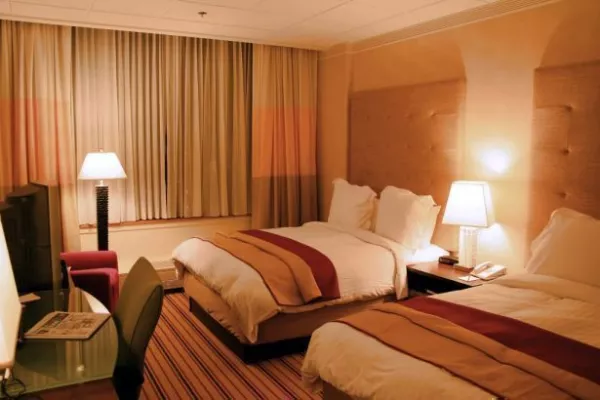Of all the weird structures that have been converted into hotels—prisons, caves, grain silos, large blocks of ice—the new, one-room Krane in Copenhagen ranks as one of the more unusual. It’s built, as its name suggests, in a former coal crane on the Nordhavnen waterfront, a former industrial port northeast of the city center that’s in the midst of a massive adaptive reuse project.
The Krane looks both stark and gorgeous, with a glass-walled meeting room, a second-floor spa, and a bedroom, 50 feet off the ground, done up in minimalist black—all wood and steel, stone and leather. For about $2,900 a night, you get the whole thing, plus an electric BMW i3 and a couple of bicycles.
What’s perhaps most surprising about the Krane, though, is not its shell (Amsterdam has a crane-based hotel, too) but that there aren’t dozens more quirky-fancy hotels like it in Copenhagen. That is, despite the Danish capital’s reputation as a leader in design, architecture, and especially food—the elementary particles of hospitality—the hotel scene has lagged behind. It’s not that Copenhagen’s hotels are bad, per se, just that they don’t measure up to or inspire excitement they way a restaurant such as Noma does.
“You have a very small number of luxury hotels that price themselves like the Ritz but feel like a Danish interpretation of what a grand European hotel would be, which is inevitably not authentic, and way overpriced,” said Michael Molesky, the San Francisco–based founder of Marker, a travel-recommendation app, who estimates he visits Copenhagen four or five times a year.
There are, of course, boutique hotels, such as the SP34, which boasts “the largest port wine selection in Denmark,” or the Nimb, whose 17 rooms have a classical elegance but are maybe not groundbreaking. Few people I spoke with, however, evinced much enthusiasm for these. And the city does have a famous five-star hotel, the d’Angleterre, where a junior suite runs $1,180 per night. Centrally located near the water on Kongens Nytorv, the elegant 250-year-old property reopened in 2013 after a $20 million renovation and remains the preferred spot for heads of state and arena-rock stars such as U2 and Radiohead. But what about for the rest of us?
Most seem to book with Airbnb. Nearly 20,000 hosts offer lodging in Copenhagen, providing stays for 450,000 visitors from April 2016 to April 2017; the city is in Airbnb’s top 10 worldwide for active listings. Those Airbnb visitors include Andrew Richdale, the deputy editor of Saveur magazine, who booked one for his recent story on Copenhagen, “What Would It Take for an American Guy to Become Danish?”
“Since it was an immersion piece, I wanted to be in someone’s home,” he said, “and I was keen on staying in Norrrebro, too, which is great for restaurants/bars”—it’s home to Relae, Manfreds, and Grød, among others—“but has no hotels of note.”
The reasons for this absence is in large part logistical. Molesky has been looking into opening his own modest inn in Copenhagen and has run into the complications inherent in any small, old, highly regulated European city.
“There are a lot of fire protection and safety requirements for an officially registered hotel, which may require expensive renovations to an existing building,” he said. Low ceilings, few bathrooms, and protected historical details can make renovations very expensive or even impossible, he said, “and as you can imagine, there are basically zero new building sites in the center city.”
“So in theory, the city wants to encourage/allow new B&Bs/hotels in certain central areas,” he added, “but in practice there aren't many viable sites.”
That doesn’t mean nothing new is opening. The Krane will be joined this fall by the 54-room Hotel Sanders, the first Copenhagen property from Kølpin Hotels, which operates two hotels in Tisvildeleje, on the North Sea coast. Designed by former ballet dancer Alexander Kølpin, the Sanders looks promising, with that quirky mix of classical and modern, local and international, that seems to be Copenhagen’s fundamental appeal. The promo website mentions “Parisian sophistication,” “English eccentricity,” and “the simplicity and sensibility of Danish design,” with staff uniforms designed by Older Paris, a group that has worked with Alexander McQueen and Isabel Marant. Alas, the Sanders may not be in Norrebro, but it’s a 5-minute walk to the old harbor of Nyhavn (where all the iconic Copenhagen pics come from) and just a bit farther to Noma and Copenhagen Street Food.
To Sanders general manager Nikolaj Tamakloe, there are issues inherent to Copenhagen that make it tricky to launch and operate ambitious hotels. Labor costs, for instance, would make it difficult for a Four Seasons or Mandarin Oriental to maintain their high staff-to-guest ratios. “Their margins would definitely be squeezed,” he wrote in an email.
Beyond that, though, cultural factors are at play. The slow development of marquee hotels, Tamakloe wrote, “may partially be a cultural trait in the Scandic countries where people are low key and very practical—in other words, not showy.”
When it came to restaurants, that was less of an issue. “The food scene found an identity, a niche, that also became a worldwide trend,” he wrote. “They were able to catch a wave, so to speak—a wholesome approach with a good helping of Danish hygge,” the concept of warm, cozy conviviality. “This very much fits with the personality of the people—a simple way of life and eating healthy.”
Expanding hygge to hotel scale, and reeling in the food and design nerds, may prove more challenging. When Sanders opens to the public in November (after a September soft open), we’ll find out if it has succeeded. Maybe then hoteliers will set their sights on Norrebro.
News by Bloomberg - edited by Hospitality Ireland









